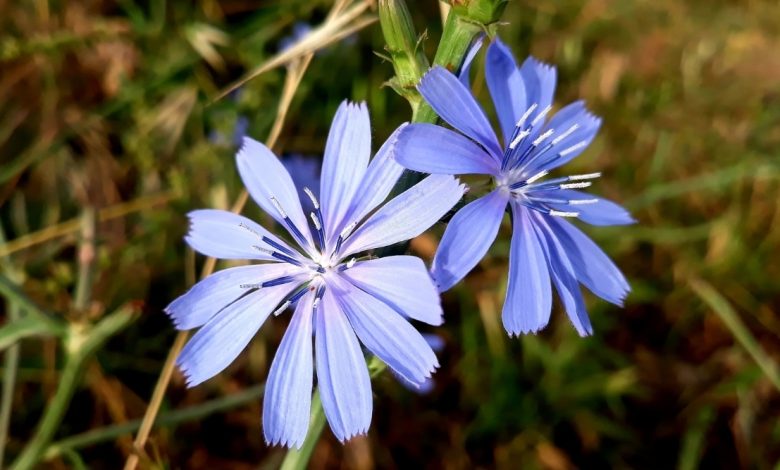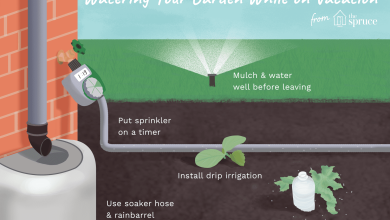Blue Flowers: [10 Examples, Care, Characteristics]

Blue flowers are a nurturing group thatare responsible for bringing an air of confidence, mystery and elegance to the place where they are.
Can use them to make internal arrangements in the home or contribute to the external composition in thegarden.
They are flowers that generate an incredible contrast with the green leaves of theirplant’sbase. However, it is a cold and generally dark color. Do you want to know some types?
Water lilies
Water liliesare blue and wildflowers that grow numerous on the spike on which they are attachedand have good size.
The most remarkable contrast is made with its inner part, which is formed ofyellow hairs, thus standing out from the structure of the petals.
To thrive, it needs tobe in a moist environment, so it is common to find them near lakes during thespringandsummer.
InSpain, it is widespread because it has managed to adapt very well to the climatic conditions generated throughout the year.
Hortensias
The hydrangeais one of the best-known andshowyspecies because ofits light blue flowers, whose central point is a beautiful pale yellow.
The main feature that makes them look beautiful is that they do not tolerate direct sun exposure or excessive heat—maintainfreshness.
Theflowersgrow close together, making it look like a series of clusters. Interestingly, different shades of blue can be obtained depending on the level of acidity of the soil where they are planted.
Campanulas
Campanulas stand out for havinga shape that resembles small bells hanging from clusters that rise.
These occupy the entire length of the stem, unlike other species usually located only at the apex of the branching.
They have small antennae inside that give them a more striking effect. In general, they are pretty attractive by themselves.
Campanula will also boost this regard for those who love fresh cooking because itcan eat its roots and leaves.
[ad_b30 id=2]Muscaris
How many times have our eyes been delighted by bulbous-looking flowers like those produced by muscaris?
It is a very characteristic blue flower thatmay also havewhiteorvioletdetails and its entire structure.
It grows around the top of a stem that rises from the base of the flower.
Its growth is around the top of a stem that rises from the base of theplantand supports the flowers that are born around it. It is a species thatadapts well to almost anyclimate, so it is often seen in gardens all over Spain.
Chinese bluebells
When you want to haveblue flowers that are a good size and grow independently,bluebellsare an excellent option.
The color is dark blue, perhaps similar tovioletin some cases. Still, you can also find varieties in pink,lilac, and even white.
They do not need a lot of care. Still, they are pretty productive in the number of flowers they generate, making them ideal at theornamentallevel.
Lobelia
It has a structure similar to the types of flowers we know, withpetals that unfold around a single pistil.
The size is variable, as there are minor or dwarf versions and larger ones, which makes it a good alternative for compositions.
[ad_b30 id=2]Cyan
Cornflowers are annuals that can beautify your garden not only with their beauty but with the fact that they are known to attract butterflies and bees.
They usually have about ten petals on each stem. These flowers need a fully sunny location to bloom continuously and well-drained soil for good root development. They are not suitable forindoor growing.
In the past, this flower was known as the«Bachelor’s button flower»because bachelors wore it to show their feelings for the girls they loved. Cyan is also the national flower of Poland.
Delphinium
Delphinium flowersare generally a symbol of solid attachment, perhaps because they are tall and need a wall or something else to attach to grow strong andbeautiful.
This also allows you to use them as part of your garden of paradise as cut flowers forvasesindoor floral designs. They also need well-drained soil and full sunlight for at least half the day to bloom continuously.
However, despite their preference for sunny locations, delphiniums are not friends of sweltering weather conditions.
They prefer summer seasons that are less dry and with not-so-high temperatures.
They also do not grow well in rainy and windy places.
[ad_b30 id=2]Clematis
Clematis is aclimbing plantthat is an excellent choice for decorating fences, walls, and different ornaments in your garden.
It comes in different colors, but the blue version is associated with courage and faithfulness.
It prefers well-drained soil and blooms modifiers if exposed to direct sunlight throughout the day.
Suppose you want to achieve a magnificent result and have a stunning ornament covered with flowers. In that case, you can pair different colors of clematis with varying shades ofroseclimbers, and it will be inspiring and magnificent!
Germanic Iris
TheGermanic Iris, orIrisblue, is a highly hardy herbaceous plant belonging to theIridaceaefamily.
It is a typical species ofcentral Europe. It is also known by the names common lily, purple lily, purple lily, blue lily, or Easter lily.
When do we grow it? It should be done in late spring and early fall.
It does not require exceptional soil. It is satisfied with fertile soils, well-drained, and ofphneutral.
We can also consider it as anornamental plant.
[ad_b30 id=2]Care of blue flowers
Most plants that produce blue flowersare moisture-loving in thesoil, so wild versions grow near lakes and rivers.
The irrigation issue should be assessed according to each species at home, taking care not to flood. For this, it is advisable to use sprays ordripand, preferably, on the base of the plant.
Watering at home should be assessed according to each species, taking care not to water the plant.
When the soil is well-nourished, there is little need for fertilization unless theplantrequires it for abundant flowering. Pruning will also be an essential issue to get the plant full of health. In that sense, it can generate blue flowers with a better presence and in greater quantity.
As in most cases,pruning will be done during rest timesand, best of all, it should only be applied to removedamagedparts of the plant.
Characteristics of this type of flowers
Blue flowers have a series of characteristics particular to their hue that we mention below:
- In many cases, their lighter or darker coloration is a function of the soil’s level of acidity.
- They tend to prefer a lighter or darker color.
- They tend to prefer shaded areas, although species grow well in open fields but with goodmoisture.
- In general, they are flowers born during the spring and summer seasons and fall in earlyfall.
- However, some versions remain on theplantthroughout the fall.
- They perform best in temperatures that are not too cold and not too hot, and they especially like cool climates.
- They are not usually veryresistantto wind gusts, so they should be kept protected in places where they may put themselves at risk.
Meaning of blue flowers
Several specific meanings can be associated with blue flowers depending on the type of purpose they are to be used for, for example:
Love
They are used in sentimental relationships that are already established, ideal for celebrating anniversaries, for example. Around this theme, they convey well-being and confidence.
Status
Blue flowers are usually seen with airs of elegance and comfort. Their use as a mechanism for decoratinginteriorsgenerates a sophisticated atmosphere.
Emotions
To work with emotions, blue flowers are good allies because they help to inspire a peaceful and calm atmosphere.
Blue flowers can be used as a complementary part of a composition with other colors or leave them as the only protagonists.
In any case, alwaysthe effect obtained will be more or less similar: serenity and balance.
[ad_b30 id=2]Bibliography and references
- Raven, Peter H.; Evert, Ray Franklin; Eichhorn, Susan E. (1992).Biology of plants.Editorial Reverté. Barcelona, Spain
- Edward Bent, Aldo Colombo. (2018).Thehortensias. Cultivation and care.Parkstone International. New York, U.S.
- Giardina, Monica. (2011).The blue rose. Elements for a phenomenology of flowers in globalized societies. Revista Investigaciones Fenomenológicas. Universidad de Buenos Aires. Buenos Aires,Argentina. Reproduced from:https://dialnet.unirioja.es/descarga/articulo/4846531.pdf
- Sañudo-Torres, Rosario Raudel; Vázquez-Peñate, Pascual; Armenta-López, Celso; Azpiroz Rivero, Hilda Susana; Campos Beltrán, Cecilia; Ibarra-Ceceña, María Guadalupe; Félix- Herrán, Jaime Alberto. (2009).Pre-germinative treatments inseedsof ironwood (Olneya tesota A. Gray) and propagation incompostsubstrate of water lily (Eichhornia crassipes).Revista Ra Ximhai. Autonomous Indigenous University of Mexico. El Fuerte, México. Reproducido de:http://www.redalyc.org/articulo.oa?id=46111817007

![Photo of Jasmine Vine Care: [Soil, Humidity, Pruning and Problems]](https://www.complete-gardening.com/wp-content/uploads/2022/08/jasmine-vine-care-soil-humidity-pruning-and-problems-390x220.jpg)

![Photo of Prune Ficus Robusta: [Importance, Season, Tools, Considerations and Steps]](https://www.complete-gardening.com/wp-content/uploads/2022/08/prune-ficus-robusta-importance-season-tools-considerations-and-steps-390x220.jpg)
![Photo of Compost: [Complete Guide to make your own Compost]](https://www.complete-gardening.com/wp-content/uploads/2022/08/compost-complete-guide-to-make-your-own-compost-390x220.jpg)